Directions (1-5): Study the below mentioned line chart carefully and answer the following questions.
Line chart shows the units produced (in units) and units sold (in %) by 5 different companies in a given year.
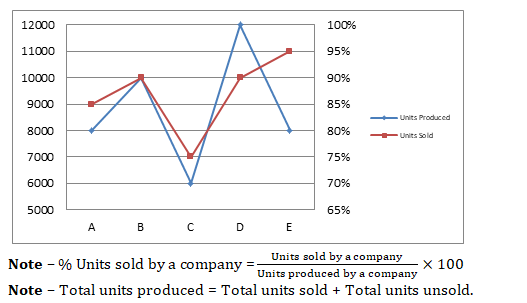
Note – % Units sold by a company = (Units sold by a company)/(Units produced by a company)×100
Note – Total units produced = Total units sold + Total units unsold.
Q.1. Find unsold units of company-A & C together is what percent of sold units of company-D?
(a) 20%
(b) 10%
(c) 30%
(d) 25%
(e) 15%

Q2. Selling price of an unit sold by company-E & company-B is Rs.15 and Rs.13 respectively. 12% and 15% of units sold by company-E & company-B respectively are returned by the customers. Then, find the difference between total revenue of company-B & company-E.
(a) Rs.970
(b) Rs.870
(c) Rs.910
(d) Rs.840
(e) Rs.810

Q.3. Revenue of company-D is Rs.48,600 more than revenue of company-C and selling price of each unit of company-C is Rs.6 more than the selling price of each unit of company-D. If profit % earned by company-C is 20%, then find the cost price of each unit sold by company-C.
(a) Rs.20
(b) Rs.15
(c) Rs.10
(d) Rs.25
(e) Rs.30

Q4. Find difference of average of unsold units of company-A, C & D and average of units sold of company-A & E.
(a) 5900
(b) 6300
(c) 5400
(d) 5200
(e) 6000

Q5. If units sold by company-F is 350% of the unsold units of company-D & E together and ratio of sold units to unsold units of company-F is 7 : 3. Then, find total units produced by company-F.
(a) 10000
(b) 9000
(c) 8000
(d) 12000
(e) 11000

Q6. If Hemant works for 20 days and Manoj works for 15 days then 3/5 th of the work has been completed. If Manoj works for 6 days and Hemant works for 16 days then 2/5 th of the work has been completed. Find in how many days both can complete the work together.
(a)30 days
(b)50 days
(c)75 days
(d)60 days
(e)Can’t be determine.
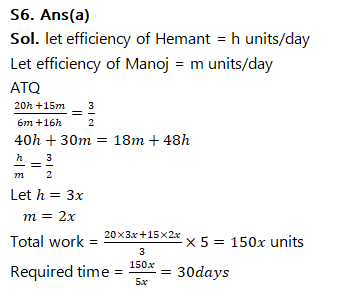
Q7. Vande Bharat express is 14% faster than Rajdhani express. They start from Delhi at same time and reach Varanasi at same time because there is a obstruction for Vande Bharat express of 7 minutes. Find speed of Vande Bharat express if distance between two destination is 285 km.
(a)300 km/h
(b)318 km/h
(c)442 km/h
(d)352 km/h
(e)342 km/h

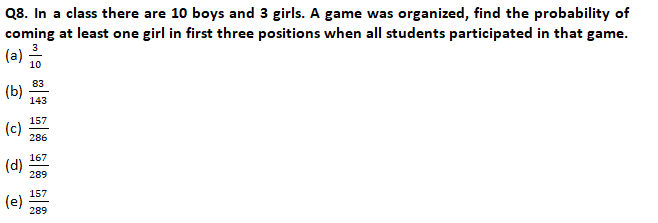

Q9. Amount of Rs. 8000 is lent at simple interest in two parts at 20% and 10% respectively. If after one year he will get Rs. 1150 as interest then find amount which was lent at 20% per annum.
(a)Rs.3000
(b)Rs.5000
(c)Rs.3500
(d)Rs.4500
(e)Rs. 4200

Q10. The expenditure and income of Manoj are in the ratio of 5:8. After some time income of Manoj is increased by 20% but at the same time his saving is also increased by ![]() . Find increased or decreased percent in his expenditure.
. Find increased or decreased percent in his expenditure.
(a)24%
(b)30%
(c)20%
(d)15%
(e)25%

Directions (11-15): The following questions are accompanied by two statements (i) and (ii). You have to determine which statements(s) is/are sufficient/necessary to answer the questions.
Q11. Efficiency of A is what percent more or less than the efficiency of B?
(i) If A and B together works for only 6 days then the remaining work is completed by B in 9 more days. In this way, they take 5 more days to do that work than the time taken by them together to do that whole work.
(ii) Time taken by B alone to complete 60% of work is 2 days less than the time taken by A alone to complete whole work.
(ii). You have to determine which statements(s) is/are sufficient/necessary to answer the questions.
(a) Statement I alone is sufficient to answer the question but statement II alone is not sufficient to answer the question.
(b) Statement II alone is sufficient to answer the question but statement I alone is not sufficient to answer the question
(c) Both the statements taken together are necessary to answer the question, but neither of the statements alone is sufficient to answer the question.
(d) Either statement I or statement II by itself is sufficient to answer the question.
(e) Statements I and II taken together are not sufficient to answer the question.
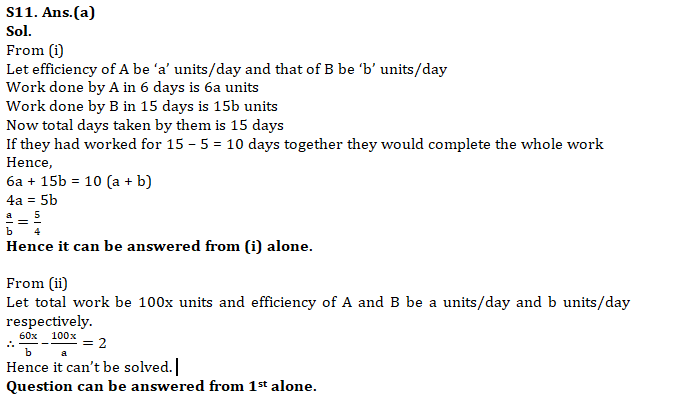
Q12. Abhi and Bindu are standing on opposite ends of a road. What is difference between their speed (in km/hr).
(i) Ratio of their (Abhi: Bindu) running speed is 2: 3 and time taken by each of them to cross whole road by running is 7.5 hours & 5 hours respectively.
(ii) They had started running and each of them after reaching their opposite end points, running back to their initial point and meet again after 9 hours from the time they had initially started race. If distance between them is 150km.
(ii). You have to determine which statements(s) is/are sufficient/necessary to answer the questions.
(a) Statement I alone is sufficient to answer the question but statement II alone is not sufficient to answer the question.
(b) Statement II alone is sufficient to answer the question but statement I alone is not sufficient to answer the question
(c) Both the statements taken together are necessary to answer the question, but neither of the statements alone is sufficient to answer the question.
(d) Either statement I or statement II by itself is sufficient to answer the question.
(e) Statements I and II taken together are not sufficient to answer the question.

Q13. Let x be total number of balls in a bag and balls are of three different colors i.e. black, white and red. Calculate (x-1).
(i) Probability of getting a black ball is ⅙, a red ball is ⅙ & a white ball is ⅔.
(ii) If 1 black and 8 white balls are lost then the probability of getting a red ball is 4/15.
(ii). You have to determine which statements(s) is/are sufficient/necessary to answer the questions.
(a) Statement I alone is sufficient to answer the question but statement II alone is not sufficient to answer the question.
(b) Statement II alone is sufficient to answer the question but statement I alone is not sufficient to answer the question
(c) Both the statements taken together are necessary to answer the question, but neither of the statements alone is sufficient to answer the question.
(d) Either statement I or statement II by itself is sufficient to answer the question.
(e) Statements I and II taken together are not sufficient to answer the question.

Q14. A and B make an investment in a business and amount invested by B is 40% more than that of A. What is the profit share of B.
(i) B invested Rs. 3500 and A invested for 12 months & B invested for 9 months and 2% of A’s profit is Rs. 160.
(ii) Time for which they (A: B) invested is in the ratio of 4 : 3 and A got Rs. 400 less than that of B as profit share.
(ii). You have to determine which statements(s) is/are sufficient/necessary to answer the questions.
(a) Statement I alone is sufficient to answer the question but statement II alone is not sufficient to answer the question.
(b) Statement II alone is sufficient to answer the question but statement I alone is not sufficient to answer the question
(c) Both the statements taken together are necessary to answer the question, but neither of the statements alone is sufficient to answer the question.
(d) Either statement I or statement II by itself is sufficient to answer the question.
(e) Statements I and II taken together are not sufficient to answer the question.

Q15. Calculate the cost price of item?
(i) The profit earn on item is 33⅓% and MP of item is Rs 4 less than twice of its SP.
(ii) Discount given on item is Rs 28.
(ii). You have to determine which statements(s) is/are sufficient/necessary to answer the questions.
(a) Statement I alone is sufficient to answer the question but statement II alone is not sufficient to answer the question.
(b) Statement II alone is sufficient to answer the question but statement I alone is not sufficient to answer the question
(c) Both the statements taken together are necessary to answer the question, but neither of the statements alone is sufficient to answer the question.
(d) Either statement I or statement II by itself is sufficient to answer the question.
(e) Statements I and II taken together are not sufficient to answer the question.

If you want to study Quantitative Aptitude for IBPS PO Prelims then you can also check out the video given below:
- Quantitative Aptitude Study Notes for Bank Exams
- Quantitative Aptitude Questions for all Competitive Exams

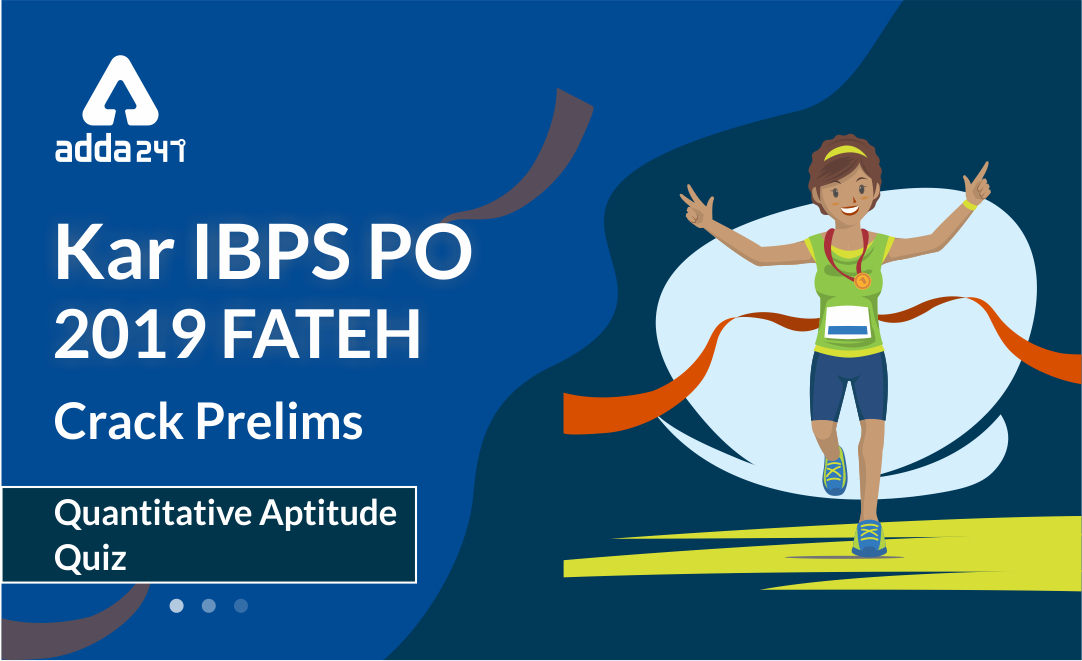
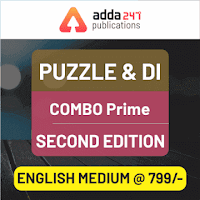


 GA Capsule for SBI Clerk Mains 2025, Dow...
GA Capsule for SBI Clerk Mains 2025, Dow...
 The Hindu Review October 2022: Download ...
The Hindu Review October 2022: Download ...
 30 Days Study Plan to Crack SBI Clerk 20...
30 Days Study Plan to Crack SBI Clerk 20...





